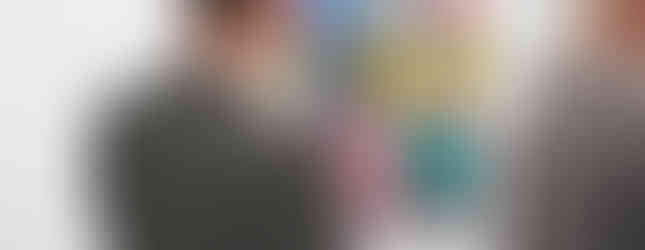photos from the opening night of the exhibition of OBA (R. Grzyb & M. Osiowski)
- M. Osiowski

- Oct 11, 2019
- 3 min read
"I pop a beautiful sentence into my mouth and suck it like a fruit drop"
HOS Gallery | Dzielna 5 | 00-162 Warsaw
exhibition: 10.10-23.11.2019
The exhibition’s title was taken from one of the opening sentences of Bohumil Hrabal’s novel “Too loud a solitude”. In the year of the book’s publication (1976), the Czech writer was Grzyb’s and Osiowski’s contemporary. What the artists also had in common manifested both in their characteristic sense of humour, sensitivity combining wit and melancholy, and the experience of creating in the shadow of the communist system. The associations of the narrator of “Too loud a solitude” with Grzyb and Osiowski are also manifested in their love of books, undiscovered worlds created by literature and philosophy. The written word plays a considerable role in the work of each of the painters; it inspires them to paint, stimulates their imagination, and encourages philosophical reflection as well as a more careful observation of how language is used in everyday life. The works presented at the exhibition reflect these inspirations. Both individual and these created as part of the OBA project, the paintings are inspired by the artists’ readings and employ the written word as a compositional element. That is why their paintings reveal direct references to the work and biography of such figures as Georg Trakl, George Orwell, Ludwig Wittgenstein, and Plato.
Grzyb has been writing poetry since highschool. The artist considers it a medium of expression equivalent to painting. At the beginning of the 2000s, Grzyb created paintings that he provisionally called “written”; they combine painting and texts taken from various sources. In turn, Osiowski since his student times has penned his thoughts on culture, art, social relations, own experiences in the form of loose notes, which last year were the basis of his artistic action “Milking van Gogh”. . Both individual and these created as part of the OBA project, the paintings are inspired by the artists’ readings and employ the written word as a compositional element. The content and emotions alike are carried not only by the message of the linguistic layer of painted words, but also by their typographical form. Both in their final formal shape and in their meaning, these paintings are made of the word and the paint. Words appear in different configurations, criss-crossing and intersecting.Words appearing on the canvas evade literalness, enriched with colour and texture, and entangled in new contexts and content.
The relationship between the graphic form of signs and the patterns of meanings is sometimes revealed through the titles that play an important role linking the artists and the audience. Often the titles are quotes taken from other literary works or song lyrics. In this context, they are elements of the painting structure. Even though hidden on the reverse of the canvas, they help to reveal new meanings of the visual layer; they are catalysts of ambiguity, associations, and unlimited peregrinations of imagination. sometimes disappointment, fatigue, or a certain mood of catastrophism.
Both Hrabal’s book, from which the exhibition’s title was taken, and the paintings displayed at the exhibition, combine humour with seriousness, realism with magic and surrealism. Hrabal’s book is said to be poetry written in prose, whereas in the case of Grzyb and Osiowski it is poetry written in painting.

OBA, "Third Face", 2019, acrylic on canvas, 200 x 150 cm
about the OBA project
The OBA is the name of joint painting activities of Ryszard Grzyb and Marcin Osiowski. The artists treat the outcomes of this cooperation not only as an extension of their individual explorations, but above all as an autonomous value that is crystallized during conversations and joint painting sessions held more or less regularly since 2002. What inspired them to paint together and brought them together as persons and painters, is a sense of humour and sensitivity to the absurdities of everyday life. The painters started cooperation without any preliminary assumptions, goals or programmes. They found inspiration in their own notes, books they had read, travel photographs, observations of events taking place in their immediate surroundings. The concept of a canvas is agreed upon together, it mainly deals with formal issues and is created in the process of translating words into visual language. They divide their roles spontaneously – the one who paints has the confidence and knows what gesture should be made at a given moment. Their joint sessions look like jam sessions, improvisations and and is derived from mutual sympathy and a certain similarity of characters, intellectual bond and views on art in general.
photos by Adam Gut




























































Comments